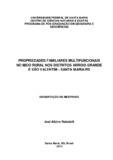| dc.creator | Rabaiolli, Joel Albino | |
| dc.date.accessioned | 2014-11-26 | |
| dc.date.available | 2014-11-26 | |
| dc.date.issued | 2013-09-27 | |
| dc.identifier.citation | RABAIOLLI, Joel Albino. MULTIFUNCIONAL FAMILY PROPERTIES IN THE RURAL CLASS IN DISTRICTS OF ARROIO GRANDE AND SÃO VALENTIM - SANTA MARIA, RS. 2013. 119 f. Dissertação (Mestrado em Geociências) - Universidade Federal de Santa Maria, Santa Maria, 2013. | por |
| dc.identifier.uri | http://repositorio.ufsm.br/handle/1/9408 | |
| dc.description.abstract | This research analyzes the transformations of agrarian sector of Santa Maria RS, perspective of socioeconomic development, with the main objective of studying, evaluating and interpreting these transformations that represent the socio-spatial class called rural. These changes are focused on the optical properties of the multifunctional family of rural class. Even presenting difficulties as access, lack of health services, education, employment, salary and "discomfort" of life, expectations point to new roles that are important in the context of contemporary development to the rural class. To avoid the emptying of the countryside and the imminent collapse of the internal supply, the Brazilian government increased recovery policies and promotion of small properties of class, supporting multiple functions and exploration of cultural knowledge in productive activities. The study of this geographical category adopted the systemic methodology, originated in general systems theory (TGS), crafted by Bertalanffy, the ideas of Morin's system and periodization of time/space based on the Scientific-Technical-Informational period, of Santos, to recognize, evaluate and interpret their dynamics that are in action, as well as the complexity of their actions established in relationships with the city that serves as the consumer market. The use of mixed method allowed to get both: qualitative data and qualitative information enabling to understand the current socio-spatial organization. We conclude that is ample the scope of agricultural and non-agricultural activities developed in the rural class and there are several functions wich identification can be performed by analysis, interpretations and reflections about the subsystems, including its fixed and flows. | eng |
| dc.description.sponsorship | Coordenação de Aperfeiçoamento de Pessoal de Nível Superior | |
| dc.format | application/pdf | por |
| dc.language | por | por |
| dc.publisher | Universidade Federal de Santa Maria | por |
| dc.rights | Acesso Aberto | por |
| dc.subject | Agricultura familiar | por |
| dc.subject | Multifuncionalidade | por |
| dc.subject | Meio rural | por |
| dc.subject | Propriedades familiares | por |
| dc.subject | Familiar agriculture | eng |
| dc.subject | Multifunctionality | eng |
| dc.subject | Rural class | eng |
| dc.subject | Familiar properties | eng |
| dc.title | Propriedades familiares multifuncionais no meio rural nos distritos Arroio Grande e São Valentim - Santa Maria/RS | por |
| dc.title.alternative | Multifuncional family properties in the rural class in districts of Arroio Grande and São Valentim - Santa Maria, RS | eng |
| dc.type | Dissertação | por |
| dc.description.resumo | A presente pesquisa analisa transformações do setor agrícola de Santa Maria - RS, perspectivas de desenvolvimento sócio-econômico, tendo como objetivo principal estudar, avaliar e interpretar estas transformações que representam a categoria sócio-espacial denominada meio rural. Tais alterações são focadas na óptica da multifuncionalidade das propriedades familiares do meio rural. Mesmo apresentando dificuldades de acesso, ausência de serviços de saúde, educação, emprego, salário e desconforto de vida, as expectativas sinalizam para novos papéis com importância no contexto do desenvolvimento contemporâneo para o meio rural. Para evitar a evasão do campo e o eminente colapso no abastecimento interno, o Estado brasileiro ampliou políticas de recuperação e promoção das pequenas propriedades no meio rural, apoiando as múltiplas funções e a exploração dos saberes culturais nas atividades produtivas. O estudo desta categoria geográfica adotou a metodologia sistêmica, originada na Teoria Geral dos Sistemas (TGS), trabalhada por Bertalanffy, as ideias de sistema de Morin e da periodização do tempo/espaço com base no período Técnico-Científico-Informacional, de Santos, para reconhecer, avaliar e interpretar suas dinâmicas atuantes, assim como a complexidade de suas ações estabelecidas nas relações com o urbano que lhe serve de mercado consumidor. A utilização do método misto permitiu angariar dados quantitativos e informações qualitativas possibilitando a compreensão da atual organização sócio-espacial. Conclui-se que é ampla a abrangência das atividades agrícolas e não agrícolas desenvolvidas no meio rural variando suas funções cuja identificação pode ser realizada pelas análises, interpretações e reflexões a respeito dos subsistemas, englobando seus fixos e fluxos. | por |
| dc.contributor.advisor1 | Miorin, Vera Maria Favila | |
| dc.contributor.advisor1Lattes | http://lattes.cnpq.br/2237199224220458 | por |
| dc.contributor.referee1 | Ferreira, Darlene Aparecida de Oliveira | |
| dc.contributor.referee1Lattes | http://lattes.cnpq.br/1693558682186525 | por |
| dc.contributor.referee2 | David, Cesar de | |
| dc.contributor.referee2Lattes | http://lattes.cnpq.br/2003244296217013 | por |
| dc.creator.Lattes | http://lattes.cnpq.br/8237455313352618 | por |
| dc.publisher.country | BR | por |
| dc.publisher.department | Geografia | por |
| dc.publisher.initials | UFSM | por |
| dc.publisher.program | Programa de Pós-Graduação em Geografia | por |
| dc.subject.cnpq | CNPQ::CIENCIAS HUMANAS::GEOGRAFIA | por |


